
Overview
This article presents proven strategies designed to significantly boost website conversion rates, underscoring the critical role of data-driven approaches and user experience optimization. By detailing various effective methods—such as:
- Refining checkout processes
- Conducting A/B testing
- Leveraging customer insights
It illustrates how these techniques have led to remarkable improvements in conversion metrics across diverse industries. Each strategy is backed by substantial evidence, reinforcing the importance of a systematic approach to enhancing user engagement and driving conversions.
Introduction
A website's conversion rate transcends mere statistics; it embodies the effectiveness with which a business transforms visitors into customers. As the landscape of online competition grows increasingly fierce, grasping the intricacies of conversion rate optimization (CRO) becomes essential for brands aiming for sustainable growth. This article explores ten proven strategies that not only elevate conversion rates but also empower businesses to optimize their existing resources. Yet, amidst the myriad of available tactics, which truly yield tangible results? Delving into actionable insights and industry best practices may unlock significant revenue potential.
Parah Group: Implement High-Velocity CRO Programs to Enhance Conversion Rates
Parah Group stands at the forefront of high-velocity programs aimed at improving the website conversion rate, emphasizing swift execution and measurable outcomes. These programs are meticulously crafted using data-informed strategies and a deep understanding of consumer psychology, aimed at enhancing conversion effectiveness. This approach empowers companies to optimize their existing resources, ensuring that every element of their marketing strategy is strategically aligned to drive growth without incurring additional advertising costs.
Current trends indicate that refining checkout processes, enhancing product page aesthetics, and leveraging targeted email marketing significantly reduce friction and improve the website conversion rate. Industry insights reveal that companies implementing these strategies frequently witness substantial enhancements in website conversion rates, with some reporting increases of up to 11.97% through effective A/B testing. Furthermore, experts assert, "CRO is essential for maximizing marketing spend, increasing customer lifetime value, lowering acquisition costs, and ultimately boosting revenue." This underscores the profound influence of on profitability and sustainable growth.
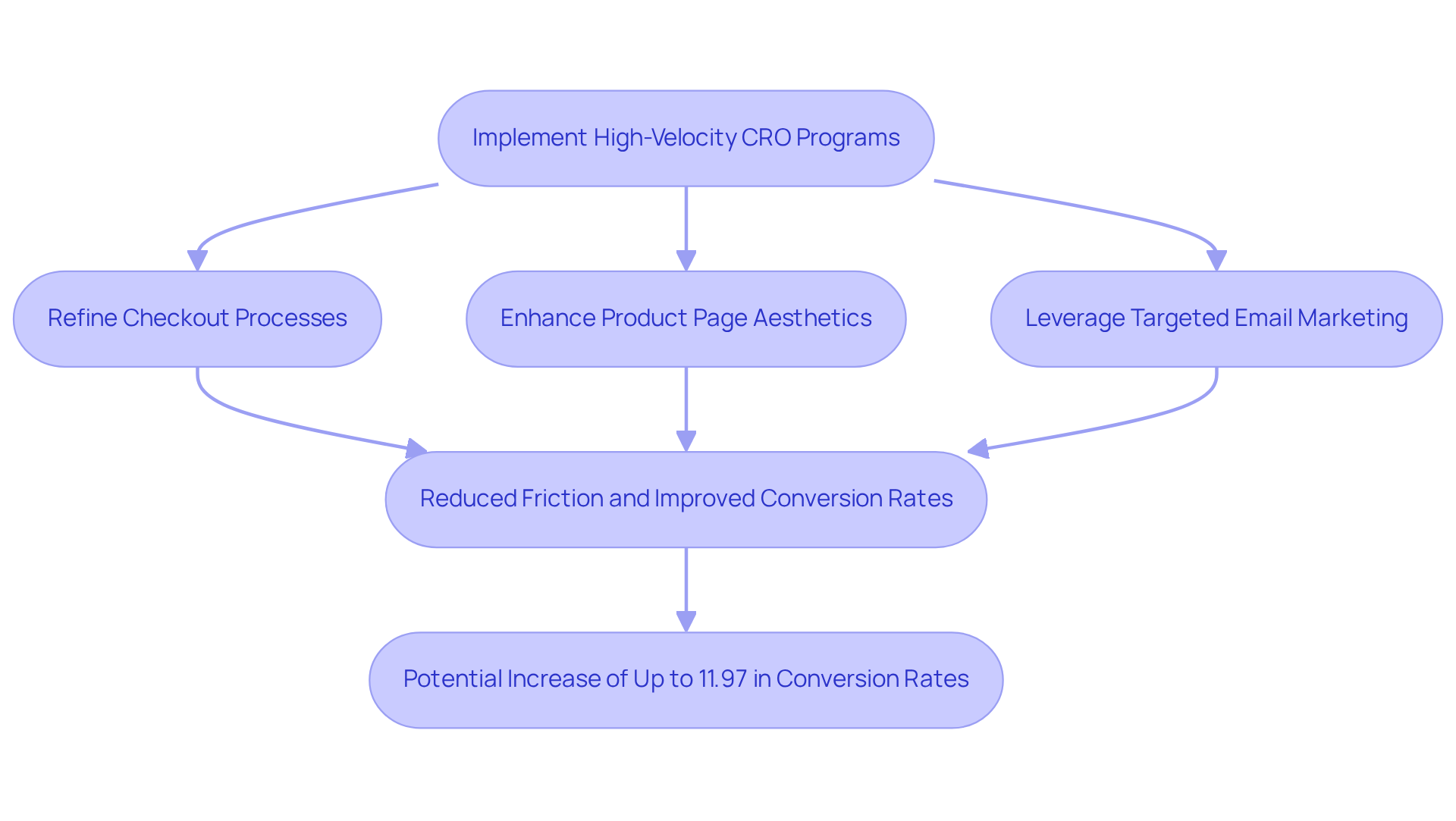
User Session Recordings: Analyze Visitor Behavior for Targeted Improvements
User session recordings deliver invaluable insights into real-time interactions on websites, ultimately helping to improve the by empowering brands with critical data. By meticulously analyzing these recordings, businesses can:
- Pinpoint essential drop-off points that influence the website conversion rate.
- Discern which elements capture user attention.
- Evaluate navigation efficiency.
This focused examination not only reveals average transformation percentages across various sectors—such as 4.6% in professional services and 2.1% in B2C—but also highlights areas for enhancement that could positively impact the website conversion rate. For instance, streamlining navigation and enhancing call-to-action visibility can significantly reduce abandonment levels, which can lead to a higher website conversion rate, as evidenced by Buildium's impressive 22% increase in free-trial sign-ups through improved testimonial headings.
At Parah Group, we adopt a holistic, data-driven approach to improving the website conversion rate through Conversion Rate Optimization (CRO), prioritizing high-velocity testing and the alignment of paid ads with landing pages. By implementing informed changes based on user behavior, companies can cultivate a more engaging user experience, ultimately driving a higher website conversion rate and fostering customer loyalty. Our proven strategies, illustrated in our case studies, have consistently yielded substantial revenue growth and enhanced profitability for Direct-to-Consumer (DTC) companies, with metrics indicating increases in website conversion rates and average order values.
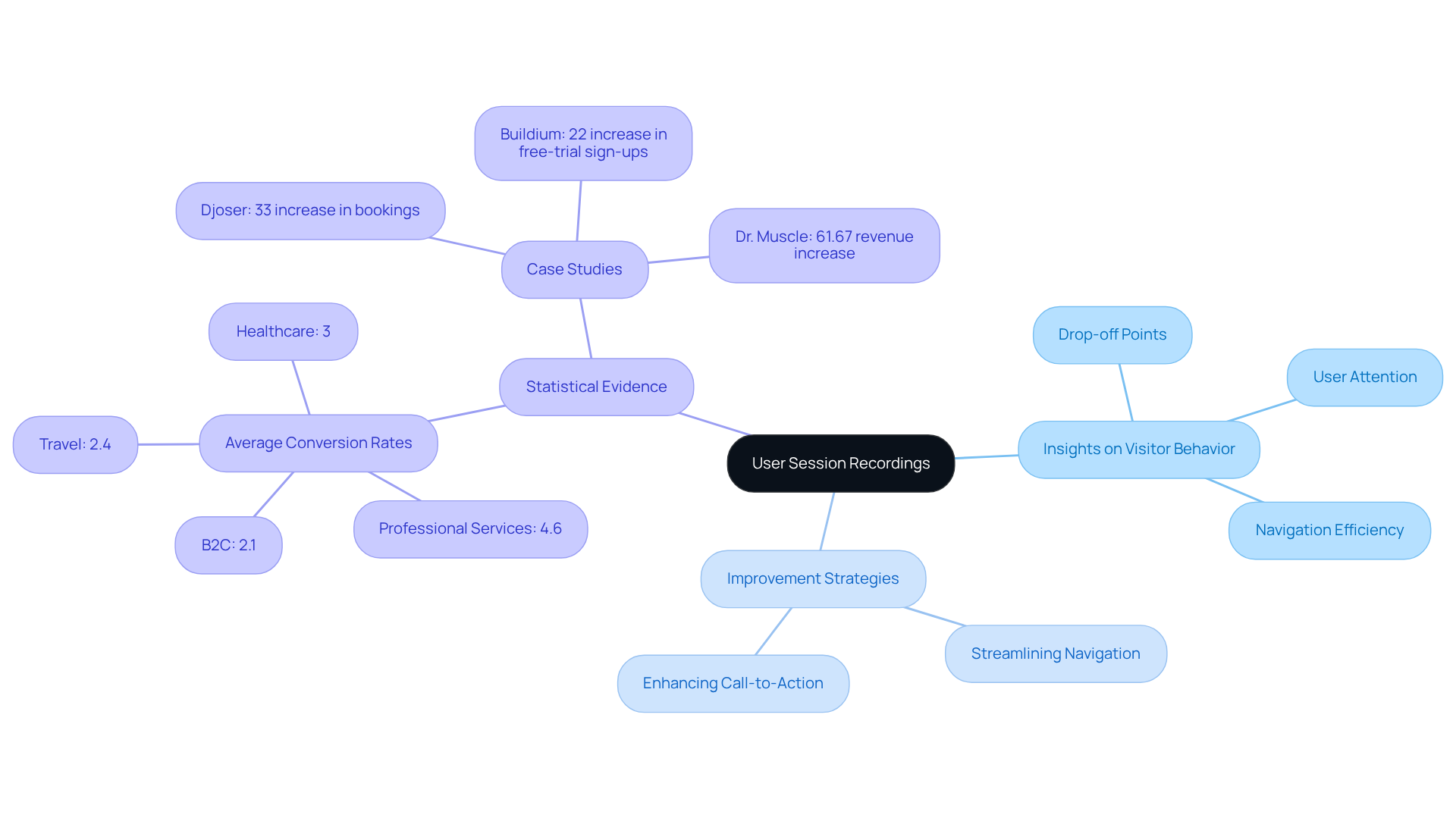
Competitor Analysis: Leverage Market Insights to Outperform Rivals
Conducting a comprehensive competitor analysis is essential for companies aiming to excel in their market. By scrutinizing competitors' strengths and weaknesses, businesses can uncover gaps in their own offerings and seize opportunities for improvement. This strategic insight allows companies to refine their and product lines, aligning them more closely with consumer preferences.
Consequently, businesses that utilize these insights can achieve substantial increases in their website conversion rate. Data shows that companies leveraging competitor insights can enhance their website conversion rate by up to 20%, highlighting the concrete advantages of informed decision-making in a competitive environment.
Furthermore, marketing professionals emphasize that a data-driven approach to understanding market dynamics not only aids in outperforming rivals but also fosters a deeper connection with consumers, ultimately driving sustainable growth.
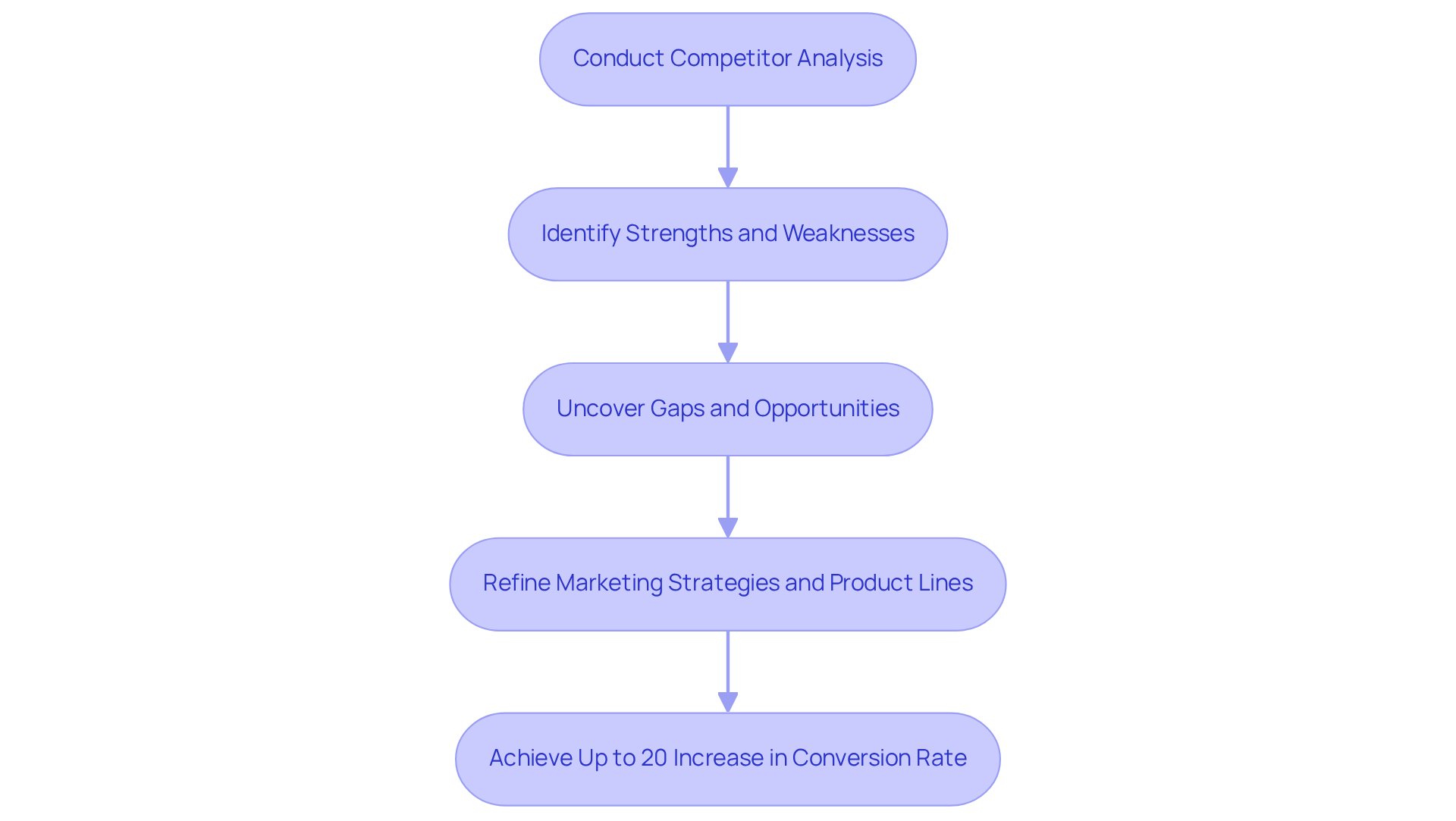
Conversion Copywriting: Create Compelling Content that Drives Action
Conversion copywriting is crucial for crafting messages that resonate profoundly with the target audience. By utilizing persuasive language and clear calls to action, brands can effectively guide visitors toward making purchases. This strategic approach not only boosts engagement levels but also ensures that marketing messages align with consumer psychology.
For example, emotionally charged language can evoke feelings that drive purchasing decisions, while specific and actionable CTAs significantly enhance user engagement. Effective examples of persuasive messaging in direct-to-consumer (DTC) marketing include:
- Emphasizing unique value propositions
- Leveraging social proof, which can enhance success rates by up to 34%
Furthermore, copy featuring a personalized call to action (CTA) is 202% more effective than that without one. Ultimately, the significance of in improving the website conversion rate cannot be overstated, as it transforms casual visitors into loyal customers.
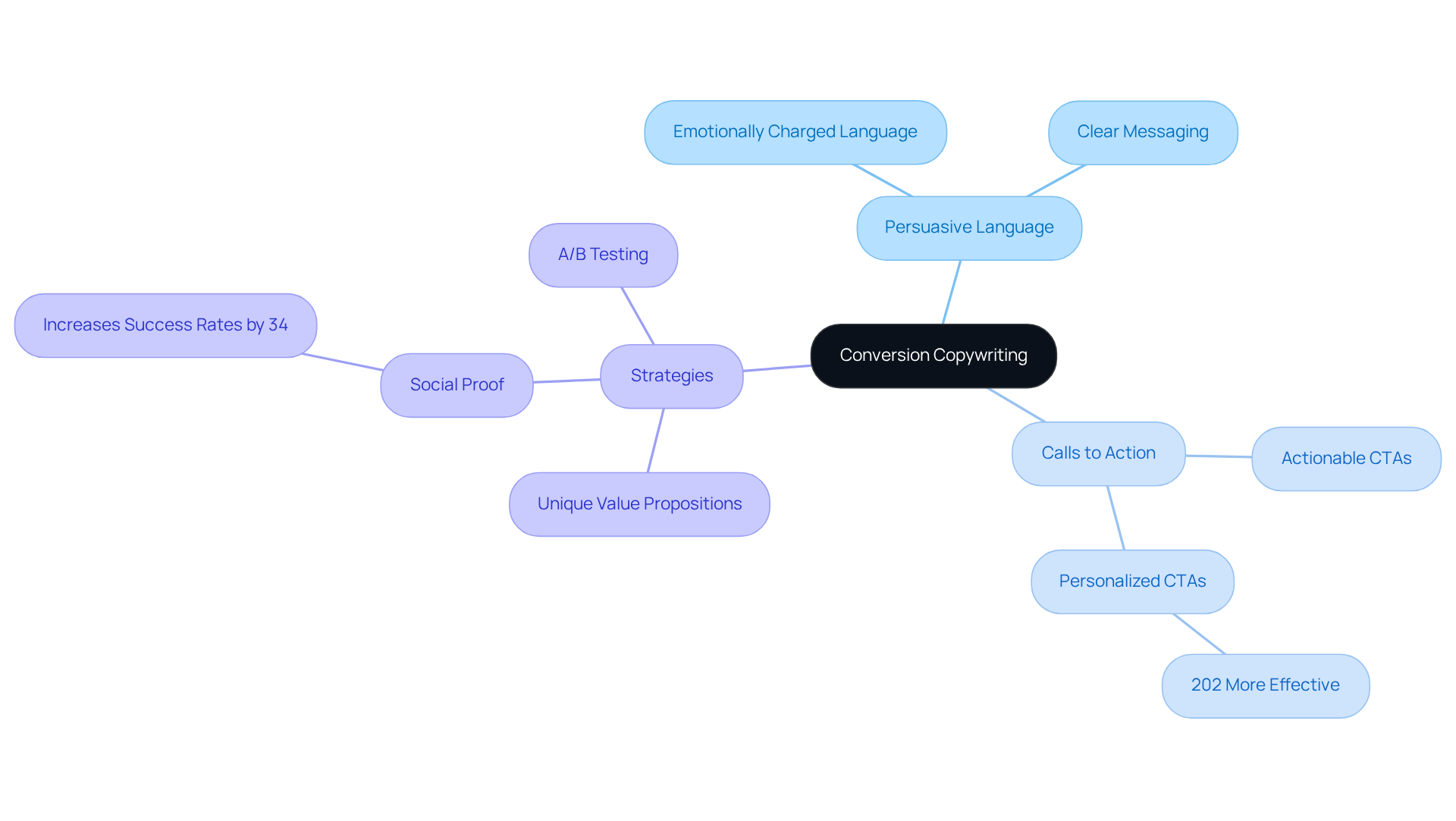
UI/UX Design: Optimize User Experience for Higher Engagement
A well-crafted UI/UX is essential for maintaining visitor engagement and encouraging deeper exploration of a website, thereby positively impacting the website conversion rate. By optimizing layout, navigation, and visual elements, brands can create a seamless experience that reduces friction and improves client satisfaction. Research indicates that 88% of individuals are less likely to return to a website after a poor experience, underscoring the need for intuitive design.
Moreover, favorable customer engagement can greatly enhance sales performance; effective UX design can lead to a substantial increase in the website conversion rate, resulting in improvements of up to 400%. Brands that prioritize user experience not only foster customer loyalty but also enhance their website conversion rate, as satisfied users are more likely to complete purchases and return for future transactions.
For instance, a small skincare company witnessed its sales percentage jump from 5% to 12% after revamping its product pages and simplifying the checkout process, effectively doubling its income from the same visitors. Similarly, Parah Group's comprehensive CRO strategies, which include rigorous testing and alignment of paid ads with landing pages, have helped brands achieve remarkable results, such as a $30M apparel brand that improved its website conversion rate by 35% through strategic UI/UX enhancements.
This emphasizes the vital role of client experience in attaining measurable business results. To start , consider conducting user testing to identify pain points and areas for improvement.
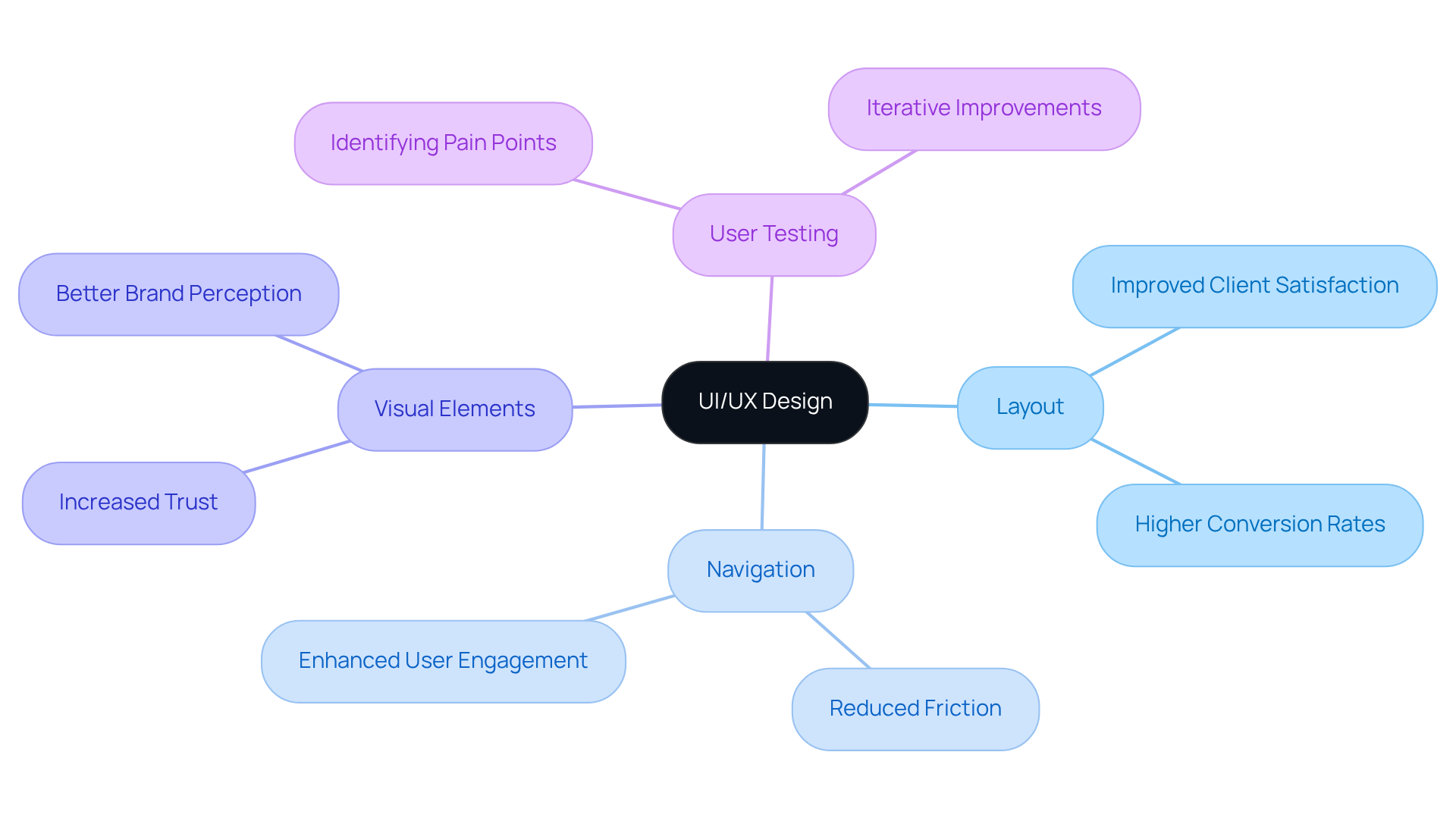
Customer Surveys: Gather Insights to Tailor Your Offerings
Customer surveys serve as indispensable instruments for companies seeking to extract direct insights from their audience. By pinpointing what customers value and the challenges they face, businesses can refine their offerings to more closely align with consumer needs. This customer-centric approach not only enhances satisfaction but also markedly .
Notably, over 70% of consumers indicate a willingness to pay a premium for sustainably produced goods, highlighting a significant alignment between consumer preferences and purchasing behavior. Additionally, survey insights reveal that 52% of individuals believe companies should act on customer feedback, emphasizing the critical role of responsiveness in nurturing loyalty.
By leveraging these insights, companies can elevate their products and services, ultimately driving higher success levels and enhancing overall profitability.
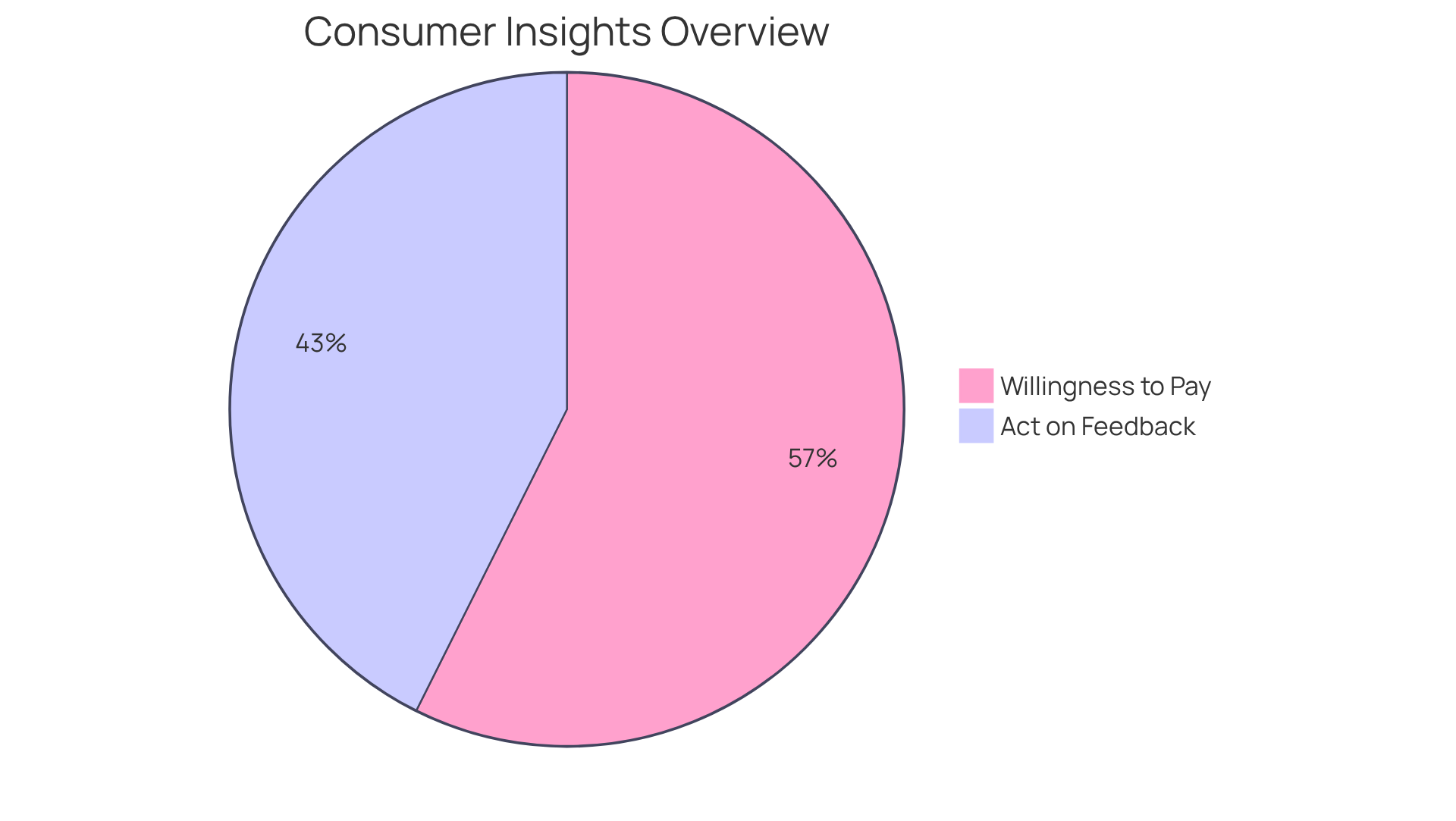
Ongoing A/B Testing: Experiment and Optimize for Maximum Impact
Continuous A/B testing serves as a powerful tool for companies seeking to enhance their online presence. By experimenting with various website elements—such as headlines, call-to-action buttons, and layout designs—businesses can systematically analyze performance metrics to identify which variations yield the highest success rates. A notable example is Parah Group's collaboration with a $30M clothing label, which led to a remarkable 35% increase in engagement levels through strategic homepage redesigns, optimized product pricing, and gamifying the progress bar for free shipping thresholds. This data-driven approach not only fosters ongoing improvement of marketing strategies but also ensures that companies remain agile in adapting to evolving consumer preferences.
With 77% of companies worldwide engaging in , leveraging these insights can significantly enhance user experience and optimize the website conversion rate. To execute effective A/B tests, it is crucial to establish clear hypotheses, maintain sufficient test durations, and conduct thorough analyses of results. This enables companies to make informed decisions that drive sustained growth.
Moreover, integrating A/B testing into major redesigns offers valuable insights prior to full implementation, ensuring that changes resonate with users and maximize impact. Parah Group's comprehensive strategy for improving the website conversion rate through meticulous testing and aligning paid ads with landing pages exemplifies how continuous A/B testing can catalyze substantial growth and profitability for direct-to-consumer (DTC) companies.
For brands aspiring to enhance their success metrics, initiating small, focused A/B tests can yield insightful data and lay the groundwork for broader optimization initiatives.

Top-Converting Traffic Channels: Prioritize Sources that Drive Sales
Recognizing traffic sources that yield the highest success levels is paramount for enhancing marketing strategies. Brands must delve into performance analytics to identify which sources—whether organic search, social media, or email marketing—are driving the most sales. Data indicates that email and SMS marketing are projected to account for at least 20% of sales in 2025, underscoring their effectiveness. By concentrating efforts on these high-performing channels, companies can significantly improve their marketing ROI and elevate overall success metrics.
Parah Group's case studies effectively illustrate this point. For instance, a $30M apparel company experienced a 35% increase in conversion rates after optimizing their homepage by emphasizing social proof and minimizing unnecessary pop-ups. Similarly, Grab Green, a $15M cleaning product company, enhanced their average order value (AOV) by 80% through strategic adjustments, such as introducing bundles and multi-packs to encourage larger purchases. These results underscore the importance of , enabling companies to tailor their messaging and enhance user experiences, which ultimately contributes to a higher website conversion rate and fosters greater customer engagement and loyalty.
As the landscape evolves, leveraging insights from traffic performance will be crucial for sustaining growth and profitability.
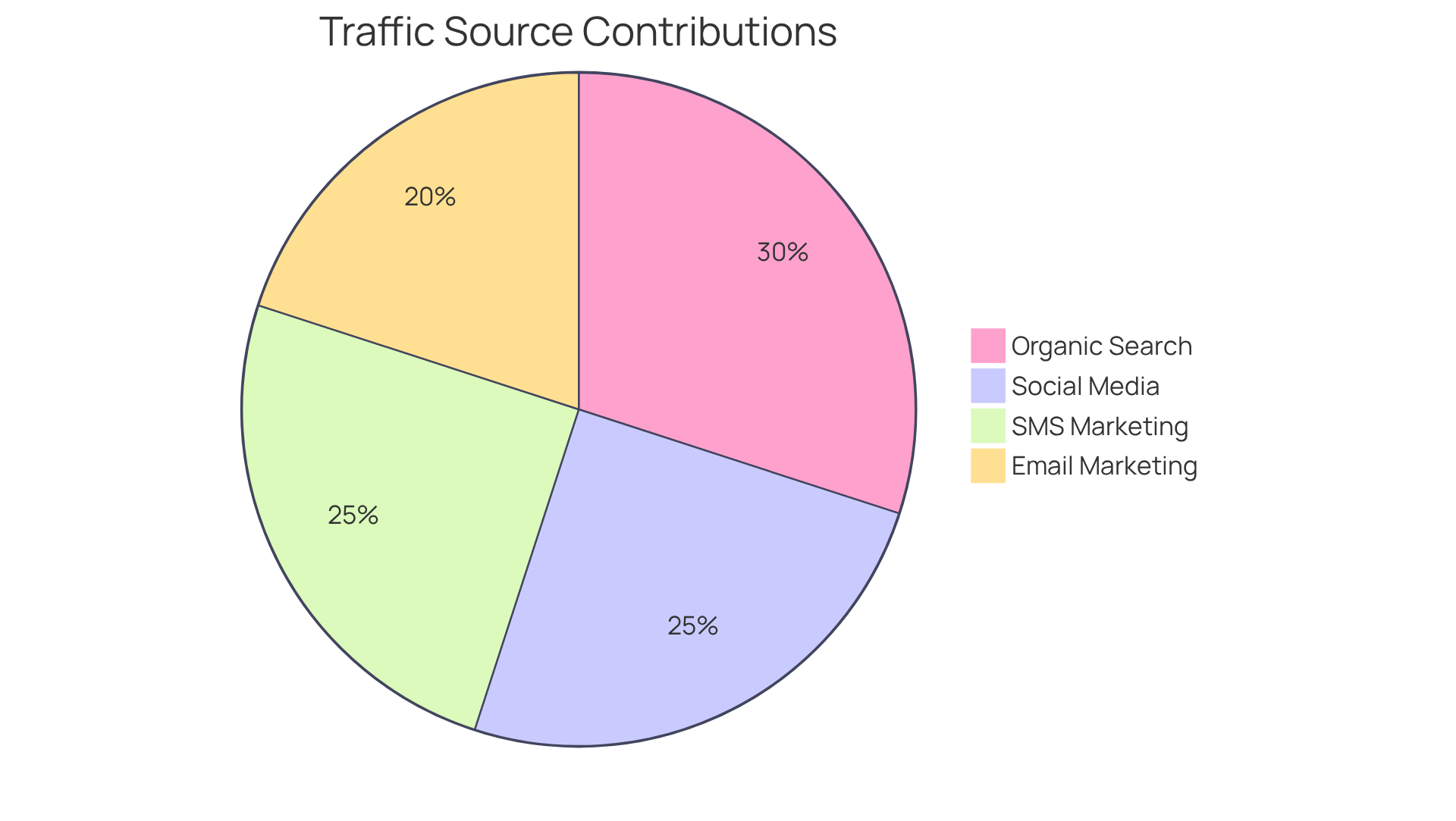
Best-Converting Products: Highlight Offerings that Maximize Revenue
To maximize revenue, brands must identify and promote their to improve their website conversion rate. By analyzing sales data and customer feedback, businesses can ascertain which offerings resonate most with their audience. Emphasizing these products in advertising initiatives not only boosts sales but also enhances overall success by concentrating efforts on established winners. Notably, success rates through site search can be up to 50% greater than the norm, with search visitors achieving a website conversion rate of 4.63%, in contrast to an average of 2.77%. Furthermore, revenue increases by 6% to 10% when personalization and proprietary customer data are integrated into marketing strategies. As Ivana Ivanovic asserts, "searchers drive more revenue, spending 2.6 times more across mobile and desktop compared to those who don’t use search." By strategically highlighting high-revenue items, brands can effectively optimize their marketing efforts and achieve substantial growth.
Actionable Tips:
- Leverage Sales Data: Regularly analyze sales performance to identify top products.
- Utilize Customer Feedback: Gather insights from customers to understand their preferences.
- Focus on Personalization: Integrate customer data to tailor marketing messages for better engagement.
- Highlight Proven Winners: Use targeted campaigns to showcase best-sellers and drive the website conversion rate.
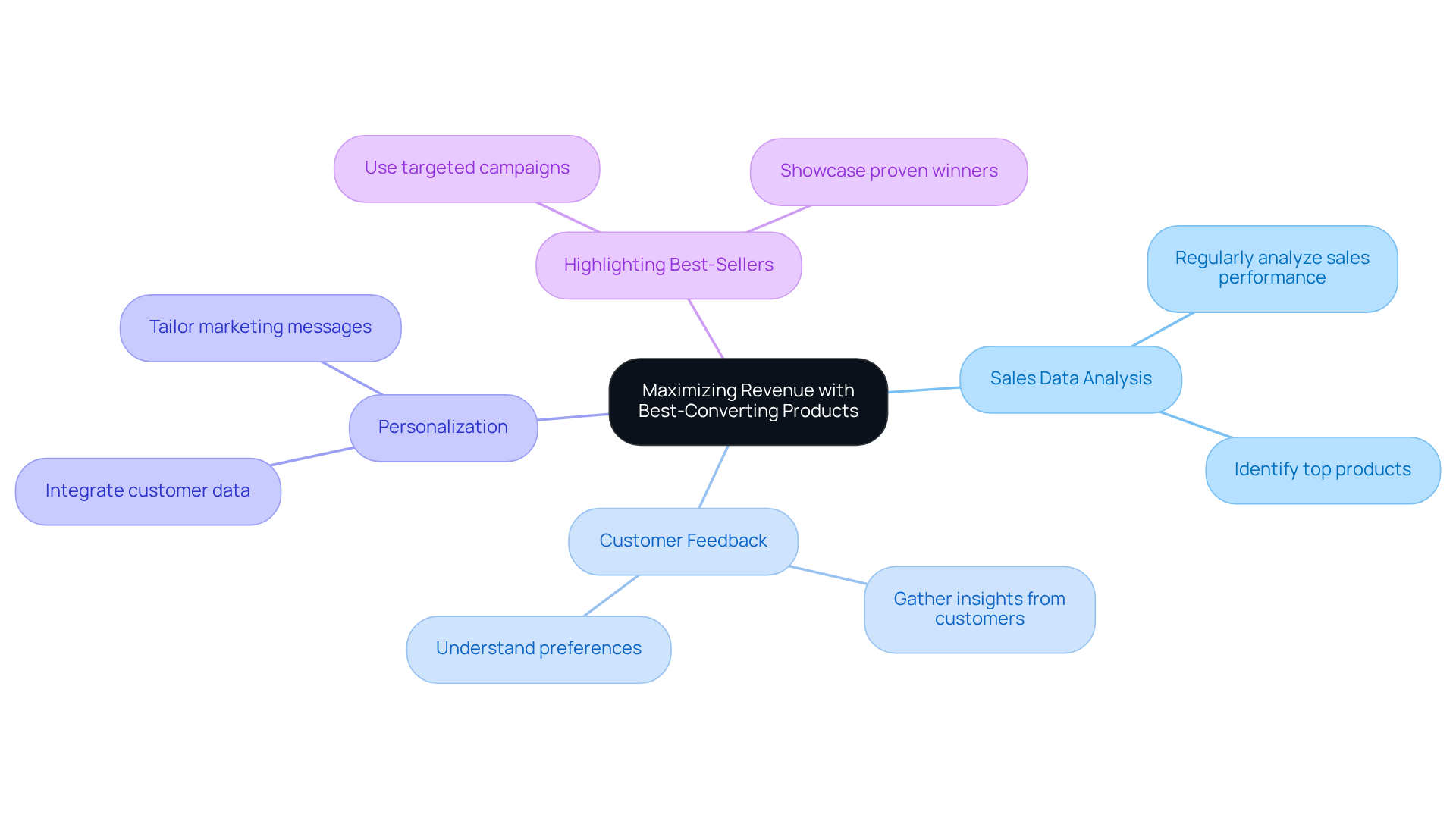
Mobile Shopping App: Enhance Accessibility for Increased Conversions
Investing in a mobile shopping app is not just a strategic move; it is a necessity for brands aiming to enhance accessibility and streamline the purchasing process for customers. With to account for approximately 59% of all online retail sales globally by 2025, companies that prioritize a seamless app experience are strategically positioned to capture a larger market share. Research shows that mobile applications achieve success rates 157% higher than mobile websites, primarily due to faster loading times and a more engaging interface. Additionally, shoppers utilizing apps view about 4.2 times more products per session than those browsing on mobile sites, resulting in average order values that are roughly 15% higher. Furthermore, the implementation of push notifications can significantly boost engagement; weekly alerts can lead to retention levels that are 2-5 times higher for retail applications. By optimizing the app experience and leveraging strategies such as push notifications, businesses can effectively enhance engagement among mobile users, maximizing every potential sale and maintaining competitiveness in a dynamic marketplace.
Parah Group advocates for a holistic and data-driven approach to improving the website conversion rate, which is also applicable to mobile platforms. Their five-step process focuses on harnessing consumer psychology to drive profitability through tailored strategies for DTC companies. For instance, in a case study involving a $30M apparel company, Parah Group revamped the homepage to highlight social proof and customer reviews, resulting in a remarkable 35% increase in the website conversion rate. As Josh Gare succinctly states, "For businesses, the takeaway is clear: make mobile a top priority." Therefore, brands must assess their current mobile app performance and consider investing in app development to enhance user experience while integrating proven CRO strategies to drive revenue growth.
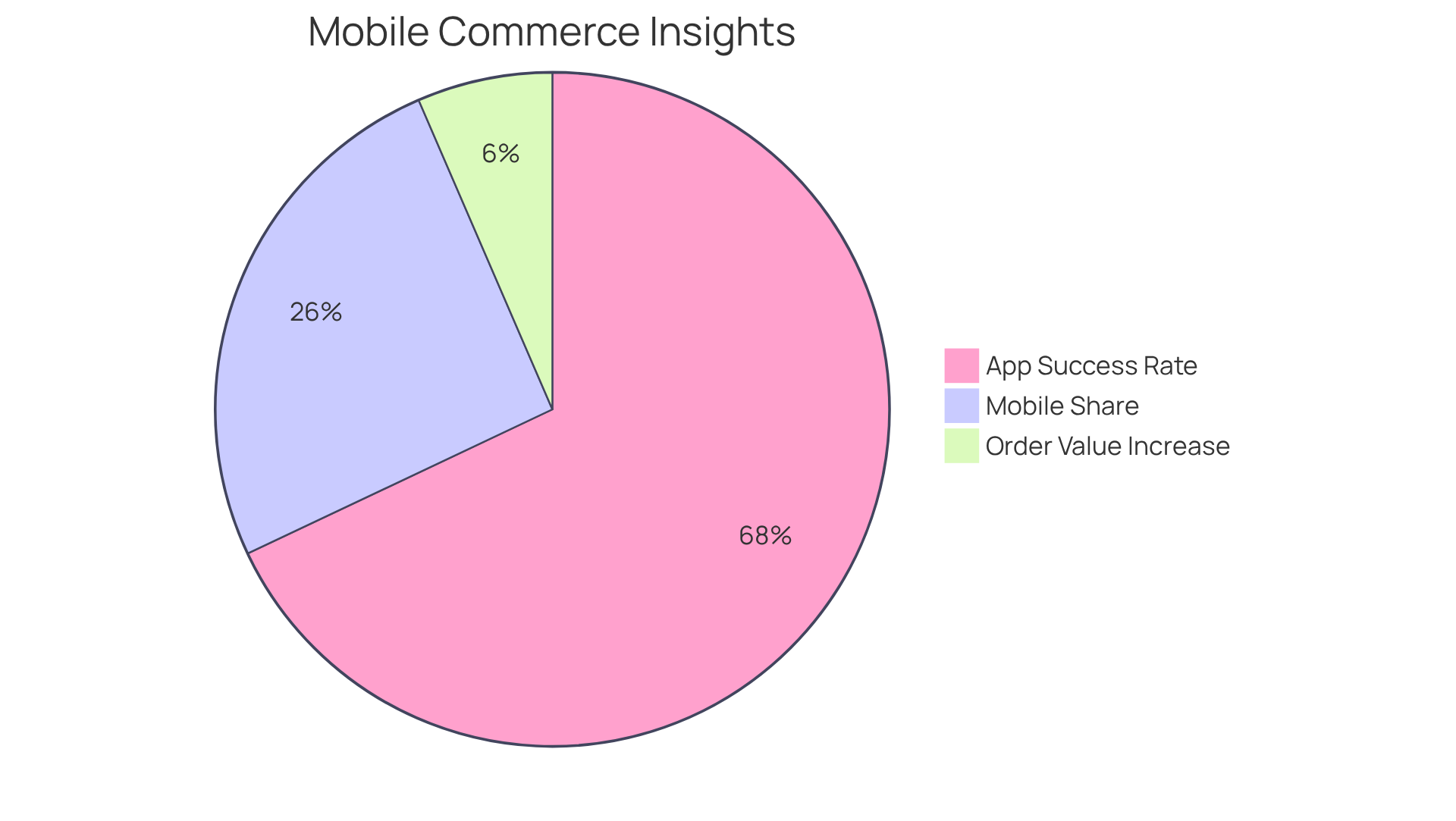
Conclusion
Implementing effective strategies to boost website conversion rates is not just beneficial; it is essential for businesses aiming to thrive in a competitive digital landscape. By focusing on high-velocity conversion rate optimization (CRO) programs, companies can leverage data-driven insights and consumer psychology to achieve significant improvements in their online performance. This multifaceted approach enhances user experience and aligns marketing efforts with customer needs, ultimately driving growth and profitability.
Key strategies include:
- Refining checkout processes
- Utilizing user session recordings
- Conducting competitor analysis
- Employing persuasive conversion copywriting
Each element plays a vital role in identifying pain points and optimizing user interactions, leading to increased engagement and higher conversion rates. Furthermore, the importance of UI/UX design, ongoing A/B testing, and a thorough understanding of traffic channels cannot be overstated; these practices ensure businesses remain agile and responsive to consumer behavior.
The significance of adopting a comprehensive and informed approach to website conversion optimization is clear. As businesses navigate the evolving digital landscape, prioritizing these proven strategies will enhance user satisfaction and maximize revenue potential. Companies are encouraged to evaluate their current practices and implement these strategies while remaining committed to continuous improvement, ensuring sustainable growth and a competitive edge in the market.
Frequently Asked Questions
What is Parah Group's approach to improving website conversion rates?
Parah Group focuses on high-velocity Conversion Rate Optimization (CRO) programs that emphasize swift execution and measurable outcomes, using data-informed strategies and insights into consumer psychology to enhance conversion effectiveness.
What strategies are currently trending for improving conversion rates?
Current trends include refining checkout processes, enhancing product page aesthetics, and leveraging targeted email marketing, all of which can significantly reduce friction and improve website conversion rates.
How effective are A/B testing and CRO strategies in enhancing conversion rates?
Companies that implement effective A/B testing and CRO strategies can experience substantial increases in website conversion rates, with some reporting improvements of up to 11.97%.
What role do user session recordings play in improving conversion rates?
User session recordings provide insights into visitor behavior, helping businesses identify drop-off points, understand which elements capture user attention, and evaluate navigation efficiency, ultimately leading to targeted improvements in conversion rates.
What are the average transformation percentages in different sectors based on user behavior analysis?
Average transformation percentages vary by sector, with professional services seeing around 4.6% and B2C around 2.1%, indicating potential areas for enhancement in conversion rates.
How can competitor analysis benefit companies looking to improve their conversion rates?
Comprehensive competitor analysis allows businesses to identify strengths and weaknesses in their offerings, uncover gaps, and refine their marketing strategies, potentially enhancing their website conversion rates by up to 20%.
What is the overall impact of high-velocity CRO programs on business profitability?
High-velocity CRO programs can maximize marketing spend, increase customer lifetime value, lower acquisition costs, and ultimately boost revenue, highlighting their significant influence on profitability and sustainable growth.
FAQs











